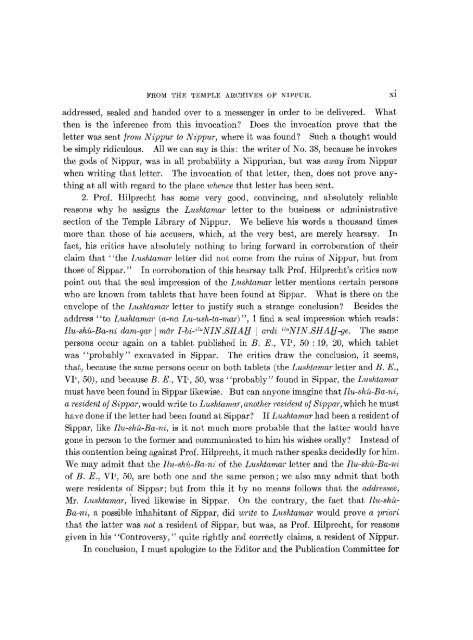THE BABYLONIAN EXPEDITION
THE BABYLONIAN EXPEDITION
THE BABYLONIAN EXPEDITION
You also want an ePaper? Increase the reach of your titles
YUMPU automatically turns print PDFs into web optimized ePapers that Google loves.
FROM <strong>THE</strong> TEMPLE ARCHIVES Ol? NIPPUR. XI<br />
addressed, sealed and handed over to a messenger in order to be delivered. What<br />
then is the inference from this invocation? Does the invocation prove that the<br />
letter was sent from Nippur to Nippur, where it was found? Such a thought would<br />
be simply ridiculous. All we can say is this: the writer of No. 38, because he invokes<br />
the gods of Nippur, was in all probability a Nippurian, but was away from Nippur<br />
when writing that letter. The invocation of that letter, then, does not prove any-<br />
thing at all with regard to the place whence that letter has been sent.<br />
2. Prof. Hilprecht has some very good, convincing, and absolutely reliable<br />
reasons why he assigns the Lushtamar letter to the business or administrative<br />
section of the Temple Library of Nippur. We believe his words a thousand times<br />
more than those of his accusers, which, at the very best, are merely hearsay. In<br />
fact, his critics have absolutely nothing to bring forward in corroboration of their<br />
claim that "the Lushtamar letter did not come from the ruins of Nippur, but from<br />
those of Sippar." In corroboration of this hearsay talk Prof. Hilprecht's critics now<br />
point out that the seal impression of the Lushtamar letter mentions certain persons<br />
who are known from tablets that have been found at Sippar. What is there on the<br />
envelope of the Lushtamar letter to justify such a strange conclusion? Besides the<br />
address "to Lushtamar (a-na Lu-ush-ta-mar) ", I find a seal impression which reads:<br />
Ilu-shh-Ba-nz dam-qar I m&r I-bi-"l"NiN.SHAff 1 ardi ""NiN.SHAH-ge. The same<br />
persons occur again on a tablet published in B. E., VI1, 50 : 19, 20, which tablet<br />
was "probably" excavated in Sippar. The critics draw the conclusion, it seems,<br />
that, because the same persons occur on both tablets (the Lushtanzar letter and B. E.,<br />
VI', 50), and because B. E., VI', 50, was "probably" found in Sippar, the Lushtamar<br />
must have been found in Sippar likewise. But can anyone imagine that Ilu-shu-Ba-ni,<br />
a resident of Sippar, would write to Lushtamar, another resident of Sippar, which he must<br />
have done if the letter had been found at Sippar? If Lushtamar had been a resident of<br />
Sippar, like Ilu-shu-Ba-ni, is it not much more probable that the latter would have<br />
gone in person to the former and communicated to him his wishes orally? Instead of<br />
this contention being against Prof. Hilpreeht, it much rather speaks decidedly for him.<br />
We may admit that the ilu-shh-Ba-ni of the Lushtamar letter and the ilu-shu-Ba-ni<br />
of B. E., VI', 50, are both one and the same person; we also may admit that both<br />
were residents of Sippar; but from this it by no means follows that the addressee,<br />
Mr. Lushtamar, 'lived likewise in Sippar. On the contrary, the fact that ilu-shi~-<br />
Ba-ni, a possible inhabitant of Sippar, did write to Lushtamar would prove a priori<br />
that the latter was not a resident of Sippar, but was, as Prof. Hilprecht, for reasons<br />
given in his "Controversy," quite rightly and correctly claims, a resident of Nippur.<br />
In conclusion, I must apologize to the Editor and the Publication Committee for

















